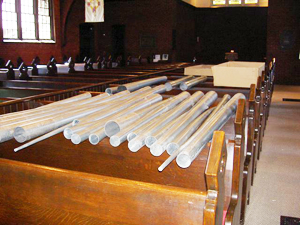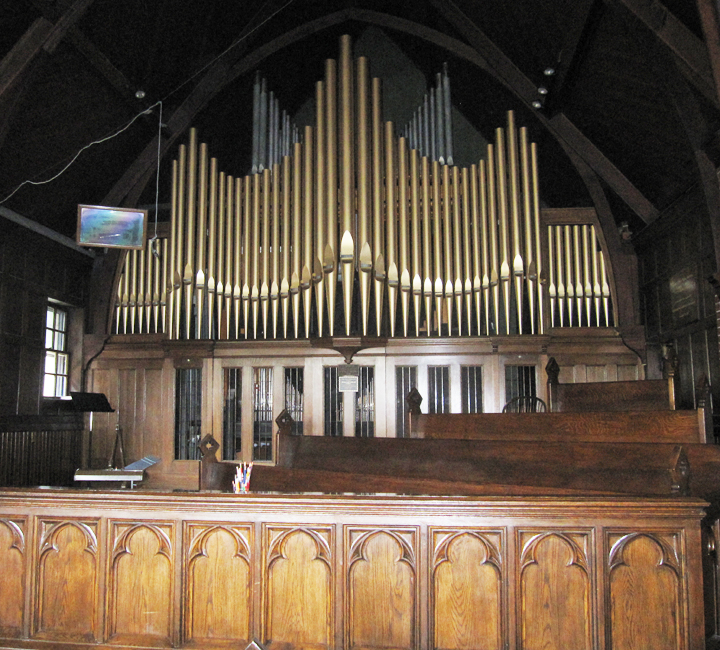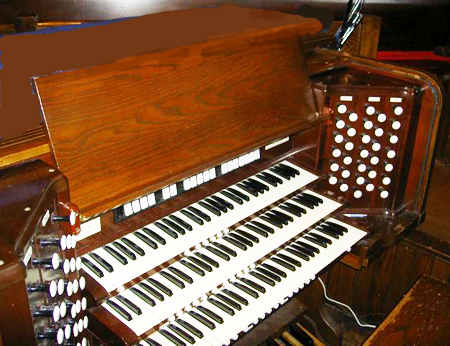
Pipes removed for restoration

Restored pipes re-installed

New console installed
|
The pipe organ at the First Parish Church of Weston has served as the primary musical instrument of the church for more than 90 years. It was first installed in 1919 by the Hook & Hastings Organ Company of Weston. It was the gift of Anna Hastings in memory of her husband, Francis Hastings who was the managing owner of the renowned firm. The firm and its
predecessor (E. & G.G. Hook of Boston) were responsible for many famous and successful instruments throughout the Northeast region of the U.S. from about 1860 to 1930. The original pipe instrument was a product of its time, and was orchestral in nature. While it was both pleasant and adequately equipped for service playing, it lacked the essential tonal ingredients
necessary for the performance and interpretation of much of the organ’s
great literature.
Over a 15-year period beginning in 1955, the instrument was mechanically and tonally rebuilt by Mr. Conrad Olson, a former employee of the Hook & Hastings firm. The project was underwritten by Anna Hall, the niece of Anna Hastings. Many of the organ’s orchestral stops were replaced with ones of a more classical style, and a number of stops were added as
well. The resulting instrument, dedicated in 1970, was eclectic in tone and far more capable of playing the breadth of the organ’s literature. It consisted
of 3 manuals and pedal, 38 speaking stops and 34 ranks of pipes.
The 1970 rebuild included a new Reisner console and electromechanical switching system, which by 2008 was failing. Investigations led to contact with the local firm of Marshall Ogletree
Associates of Needham, MA, who specialize in the design and installation of‘pipe combination’ organs. These instruments combine a new console and
digital control system built by Rodgers Instruments of Hillsboro, Oregon with
either new or existing pipework to create a type of hybrid instrument with remarkable tonal color, flexibility, and performance features. During the
investigation, it was also identified that the instrument needed a thorough cleaning, re-leathering of its many bellows, other minor repairs and a complete re-wiring using up-to-date materials. This work was completed skillfully by the Potter Rathbun Organ Company of Cranston, RI.
The completed instrument, heard for the first time in November of 2010, encompasses 38 pipe stops, 56 digital stops, and 20 audio channels with more than 2,000 watts of power. It is capable of performing music from any period and style, and will allow for the evolution of the music program through the incorporation of new technologies as time goes by.
– David Ogletree, principal
Marshall and Ogletree, Needham, MA
|
|
The Sears Chapel was dedicated on May 25, 1930. The architect was Harold B. Willis. Construction of the nave was paid out of the estate of lifelong parishioner Horace Scudder Sears, son of the Rev. Edmund Hamilton Sears (author of “It came upon a midnight clear” and our pastor 1866-1876). The Chancel was given by the Case sisters and the stained glass window is the work of W. H. Burnham of Boston and represents the childhood of Christ.
In 2002, the Chapel organ was rebuilt by Timothy Smith of Nobscot Organ Company. Mr. Smith had the following to say in the program for the rededication concert given on October 27, 2001: My goal was to create a versatile instrument of wide dynamic range, suitable for leading hymn singing, playing weddings and funerals, and rendering a significant body of organ repertoire. With only fifteen ranks speaking into a small space, I did not expect to embrace any one European school of organ design. Instead, I drew on the work of the Roosevelts in late nineteenth-century New York City, and a basic American philosophy of eclecticism.
A brass plaque was installed on the back wall with these words:
The Chapel Pipe Organ, installed 2002,
is given in Remembrance of Bill and Margaret Rousseau
and their love of music. |

